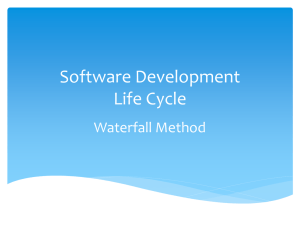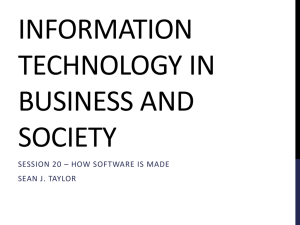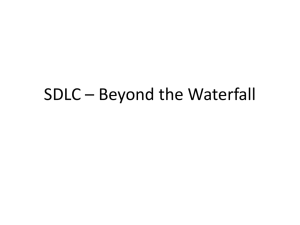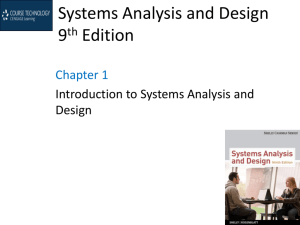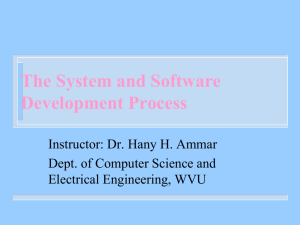Slides
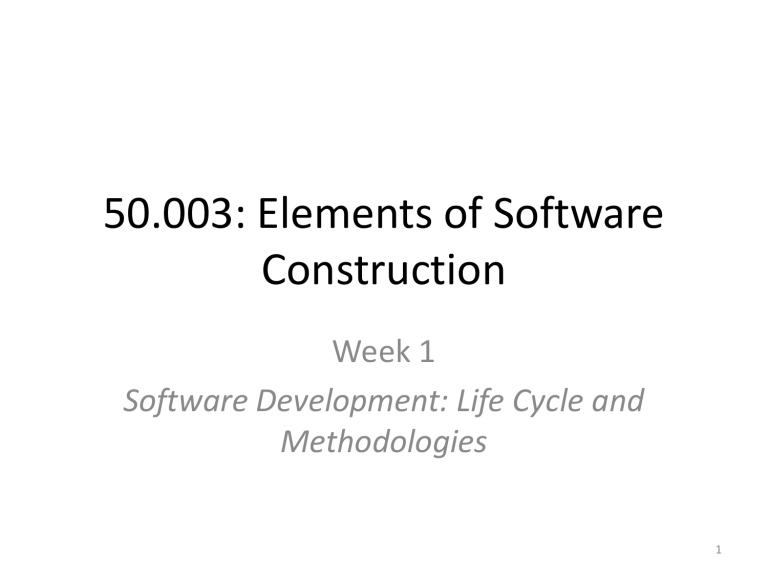
50.003: Elements of Software
Construction
Week 1
Software Development: Life Cycle and
Methodologies
1
Plan for the Week
• First Class: Overview of Software Engineering and Software Development Processes
• Second Class: More on Software Development
Processes
• Third Class: 3 guest talks
– Yong Cheng et. al., senior, SUTD
– Wenqi Liang, Senior Software Engineer, Autodesk
– Samuel et. al., senior, SUTD
Software Engineering
User Requirements the magical programming machine
System Implementation
***The synthesis problem (i.e., synthesizing a program from a specification automatically) is undecidable (i.e., there doesn’t exist an algorithm which could solve the problem in finite time).
Software Engineering
User Requirements
The species we called programmers
System Implementation
A Programmer’s Life
More Than Just Coding Skills
where we are at
Coding Skills
6
The Big Questions
• Why are we worried about methodologies?
• What is the software development life cycle
(SDLC)?
• What are the different software development methodologies?
• How to choose one methodology over another?
7
“If you want to build a ship, don’t drum up the men to gather wood, divide the work and give orders. Instead, teach them to yearn for the vast and endless sea.”
—Antoine de Saint-Exupery
8
9
10
11
12
13
14
More Than Just Coding Skills
where we are at
Coding Skills
15
Discussion
• You have a sense of the course project by now.
If you don’t, please make sure you do
• Discuss for 3 minutes on how you plan to carry out your project.
Methodologies
• Code-a-bit-test-a-bit (CABTAB)
• Waterfall
• Rapid prototyping
• Iterative and incremental
• Spiral
• Agile methods
17
CABTAB
• Code-a-bit-test-a-bit (CABTAB) is hardly recognized as a methodology, although it is widely used in programming.
• It is unsuitable for anything other than very small systems of limited scope.
We need a process!
18
Software development life cycle (SDLC)
The SDLC is the sequence of activities covering
• requirements
• analysis
• design
• implementation
• testing over which a software system is developed.
19
Requirements
• During the requirements workflow, the primary activities include
– Listing candidate requirements
– Understanding the system context through domain modelling and business modelling
– Capturing functional as well as non-functional
Requirements
• Requirements should be captured in the language of the user.
– Use cases help distil the essence of requirements as sets of action-response transactions between the user and the system (e.g., as user cases).
20
Requirements
A functional requirement is one on the functionality of the system, e.g., the system must book the movie ticket for the user at the specific time.
A non-functional requirement is one on the performance of the system, e.g., the system must book the ticket within 2 minutes.
21
Analysis
• A key theme of the analysis workflow is to understand how and where requirements interact and what it means for the system.
• Analysis also involves
– Detecting and removing ambiguities and inconsistencies amongst requirements
– Developing an internal view of the system
– Identifying the analysis classes and their collaborations
• Analysis classes are preliminary placeholders of functionality
22
Analysis
23
Design
• Deciding on the collaboration between components lies at the heart of software design.
– A component fulfils its own responsibility through the code it contains.
– A component exchanges information by calling methods on other components, or when other components call its own methods.
24
Design
• The design workflow involves
– Considering specific technologies
– Decomposing the system into implementation units
25
Implementation
• A large part of implementation is programming.
• Implementation also involves
– Unit testing
– Planning system integrations
– Devising the deployment model
26
Implementation
27
Testing
• The primary activities of the test workflow include
– Creating test cases,
– Running test procedures, and analysing test results.
• Due to its very nature, testing is never complete.
28
Test
29
Waterfall model
Software Engineering: Concepts and Applications by Subhajit Datta
(Oxford University Press, 2010)
30
Waterfall model
• The Waterfall model uses the metaphor of falling water to underline the sequential nature of software development.
• It is suited to projects of limited uncertainly and risks.
31
Waterfall Model: Problems
What do I want?
How do I do it?
32
Waterfall Model
Click Here
Cohort Exercise I (10 min)
In his 2000 Turing lecture ‘The Design of
Design’, Frederick Brooks said, ‘The Waterfall Model is Dead Wrong’. I suppose you would agree to certain extent.
The waterfall model assumes that the different stages of software development are sequential.
Discuss with your group on the actual relationship between the 5 activities in SDLC + the stage of maintenance.
34
Rapid Prototyping
Software Engineering: Concepts and Applications by Subhajit Datta
(Oxford University Press, 2010)
35
Rapid Prototyping
• Rapid prototyping recommends the building of prototypes to clarify requirements and system scope.
• The prototypes, however, should never become the final system.
36
Software Development Life Cycle versus Software Life Cycle
Software Engineering: Concepts and Applications by Subhajit Datta
(Oxford University Press, 2010)
37
Iterative and Incremental
Development
Software Engineering: Concepts and Applications by Subhajit Datta
(Oxford University Press, 2010)
38
Iterative and Incremental
Development
• In iterative and incremental development, the software system is built through a series of time-boxed development cycles—iterations— leading to tangible and testable additions to the overall system functionality—increments.
– This is an expedient model for building systems with initial ambiguity of scope and changing requirements.
39
The Agile Manifesto
“We are uncovering better ways of developing software by doing it and helping others do it. Through this work we have come to value:
Individuals and interactions over Processes and tools
Working software over Comprehensive documentation
Customer collaboration over Contract negotiation
Responding to change over Following a plan
That is, while there is value in the items on the right, we value the items on the left more” http://agilemanifesto.org/ February 2001
40
12 Agile Principles
• Customer satisfaction by rapid delivery of useful software
• Welcome changing requirements, even late in development
• Working software is delivered frequently (weeks rather than months)
• Close, daily cooperation between business people and developers
• Projects are built around motivated individuals, who should be trusted
• Face-to-face conversation is the best form of communication (co-location)
• Working software is the principal measure of progress
• Sustainable development, able to maintain a constant pace
• Continuous attention to technical excellence and good design
• Simplicity—the art of maximizing the amount of work not done—is essential
• Self-organizing teams
• Regular adaptation to changing circumstance
Cohort Exercise 2 (5 min)
You have a sense of the course project by now. If you don’t, please make sure you do
Read the Agile manifesto and principles and discuss with your team on what it means in terms of developing your project.
42
What is the Agile Method?
Click Here
Agile Method: Case Study
Click Here
Agile Method: Case Study
Click Here
Cohort Exercise 3 (10 min)
You have a sense of the course project by now. If you don’t, please make sure you do
On the basis of what we have discussed so far, which methodology do you think would be suitable for developing your class project? Agree on some timeline on some milestones.
46
In terms of timeline, how we know how much effort and time a software development project needs?
Effort
Money
Time
Resource
Project starts Project ends
Time
Effort
Time
The Software Equation
𝐵 1/3 ∗ 𝑆𝑖𝑧𝑒
𝑃𝑟𝑜𝑑𝑢𝑐𝑡𝑖𝑣𝑖𝑡𝑦
= 𝐸𝑓𝑓𝑜𝑟𝑡 1/3 ∗ 𝑇𝑖𝑚𝑒 4/3
The models basis was formed through analysis of productivity data collected from over 4000 modern day software development projects.
[1]
The software equation was derived from thePutnam-Norden-Rayleigh
Curve which can be used to show the non-linear correlation between time to complete the project and applied human effort.
[2]
52
Depends on you and your team
Depends on the scale of your project
Inverse relationship
Solving for effort
𝐸𝑓𝑓𝑜𝑟𝑡 = [
𝑆𝑖𝑧𝑒
𝑃𝑟𝑜𝑑𝑢𝑐𝑡𝑖𝑣𝑖𝑡𝑦 ∗ 𝑇𝑖𝑚𝑒
4
3
] 3 ∗ 𝐵
• Effort: project effort measured in person-months or person-years
• Size: a lines of code estimate for the project
• Time: length of project measured in months or years
• B: a special skills factor
• Productivity: a productivity parameter (depending on your team)
56
Defining B
• B, the special skills factor, is related to the size of the product.
B Value
0.16
0.18
0.28
0.34
0.37
0.39
Size of Project
5-15K
20K
30K
40K
50K
> 50K
Defining Productivity
• Research from the collected productivity data supplies initial values for productivity determined by the type of software being developed.
Productivity Value
2,000
10,000
12,000
28,000
Description
Real time embedded software
Telecommunication software
Scientific software
Business system applications
Quick Question
𝐵 1/3 ∗ 𝑆𝑖𝑧𝑒
𝑃𝑟𝑜𝑑𝑢𝑐𝑡𝑖𝑣𝑖𝑡𝑦
= 𝐸𝑓𝑓𝑜𝑟𝑡 1/3 ∗ 𝑇𝑖𝑚𝑒 4/3
• What is the relationship before time and effort in the equation?
Impossible zones
You can only operate here
You can only operate here
In case you have not noticed, this is just an example.
You do not have
15 months, not even
15 weeks!
You can pour more effort into less time, but there are limits …
“In project management, a death march is a project where the members feel it is destined to fail and/or requires a stretch of unsustainable overwork.”
“In project management, a death march is a project where the members feel it is destined to fail and/or requires a stretch of unsustainable overwork .”
Cohort Exercise 4 (10 min)
Your project needs to be completed in 3 months. The estimated size of the system you are developing is 20,000 LOC.
• Find out how much effort your team will need (assume productivity = 1200).
• The team members decide to take a break during recess week (0.25 month). Is it wise?
• Amongst the following choices, select the measure(s) you feel are most appropriate for your team to meet the original deadline and have the planned break.
– Add two new members to the team immediately?
– Every member of the team work longer hours each day?
– Re-estimate the size of the system to be lower than 20,000 LOC?
This week’s reading
• Brooks, Frederick. P., Jr.
(April 1987). "No Silver
Bullet: Essence and
Accidents of Software
Engineering". Computer 20
(4): 10–19. doi:10.1109/MC.1987.166
3532
– http://tinyurl.com/c682zju
69
References
• Datta, Subhajit , 2010. Software Engineering: Concepts and
Applications. Oxford University Press. (ISBN 978-0-19-
569656-1)
• Ulrich, Karl T. , 2011. Design: Creation of Artifacts in Society.
University of Pennsylvania. (ISBN 978-0-9836487-0-3)
• Brooks, Frederick P. , 2010. The Design of Design: Essays from a Computer Scientist. Addison-Wesley Professional.
(ISBN - 978-0201362985)
• Putnam, Lawrence H.; Ware Myers (2003). Five core metrics : the intelligence behind successful software
management. Dorset House Publishing. (ISBN 0-932633-55-
2.)
70
Homework This Week
• Meet and discuss with your group on what your App is going to be.
• Meet and discuss with your group on how you plan to finish the project within the deadline.
